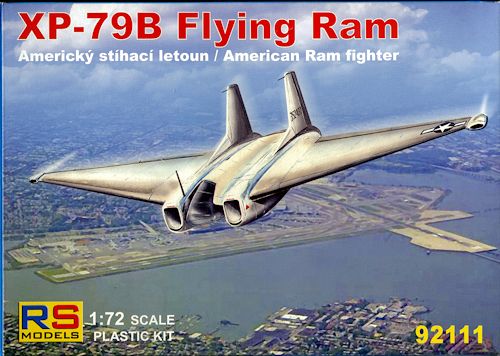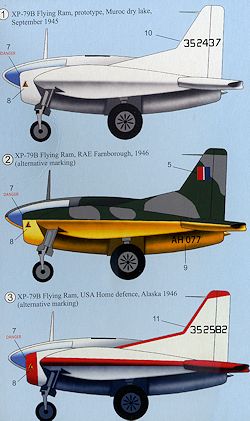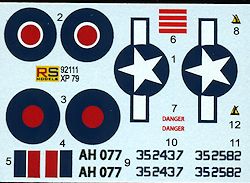
| KIT #: | 92111 |
| PRICE: | $29.95 SRP |
| DECALS: | Three options |
| REVIEWER: | Scott Van Aken |
| NOTES: | Short run kit |

| HISTORY |
In 1942, John K. Northrop conceived the XP-79 as a high-speed rocket-powered flying-wing fighter aircraft.
In January 1943, a contract for three prototypes designation XP-79 was issued by the United States Army Air Forces.
To test the radical design, glider prototypes were built. One designated MX-324 was towed into the air on 5 July 1944 by a P-38 making it the first US-built rocket-powered aircraft to fly.
Originally, it was planned to use a 2,000 lbf (9 kN) thrust XCALR-2000A-1 "rotojet" rocket motor supplied by Aerojet that used monoethyl aniline and red fuming nitric acid; because of the corrosive and toxic nature of the liquids, the XP-79 was built using a welded magnesium alloy monocoque structure (to protect the pilot if the aircraft was damaged in combat) with a ⅛ in (3 mm) skin thickness at the trailing edge and a ¾ in (19 mm) thickness at the leading edge. However, the rocket motor configuration using canted rockets to drive the turbopumps was unsatisfactory and the aircraft was subsequently fitted with two Westinghouse 19-B (J30) turbojets instead. This led to changing the designation to XP-79B. After the failure of the rocket motor, further development of the first two prototypes ended.
The pilot controlled the XP-79 through a tiller bar and rudders mounted below; intakes mounted at the wingtips supplied air for the unusual bellows-boosted ailerons. Though it was to be armed with four .50 cal machine guns, initially the aircraft was to be unarmed and to down its foes by slicing through their flying surfaces with its thick wing leading edge.
The XP-79B (after delays because of bursting tires and brake problems on taxiing trials on the Muroc dry lake) was lost on its first flight 12 September 1945. While performing a slow roll 15 minutes into the flight, control was lost for unknown reasons. The nose dropped and the roll continued with the aircraft impacting in a vertical spin. Test pilot Harry Crosby attempted to bail out but was struck by the aircraft and fell to his death. Shortly thereafter, the project was cancelled.
| THE KIT |
 Not
much plastic in the box for this one. A single grey sprue and a clear one
with the canopy rattles around in their small size box. The canopy is in two
halves split down the middle, which is where it appears there was a join
area on the real aircraft.
Not
much plastic in the box for this one. A single grey sprue and a clear one
with the canopy rattles around in their small size box. The canopy is in two
halves split down the middle, which is where it appears there was a join
area on the real aircraft.
The rest of the kit is pretty standard stuff for RS Models. Very nicely engraved detail with some rather large ejector pin stubs on the inside of the wings, intake pieces and a bulkhead piece. Easy enough to remove. The cockpit will take most of your construction time as it consists of inner walls and bulkheads as well as the flight controls. There is a pad for the pilot to lay on but it looks pretty far back in the fuselage to me.
There are intake pieces that go back about a half inch and one has to insert exhaust cones prior to closing the fuselage halves. I doubt if this will be a tail sitter, thanks to the two nose and two main landing gear assemblies. If anything, one will have to be careful to make sure all four tires touch the ground. Apparently the outer nose and outer main gear doors were normally closed, and one wonders why these parts were even included at all. The inside of the gear wells and doors is shown as chromate yellow with the interior also in this shade.

 Instructions
are well drawn and pretty minimal as you might expect from so few parts. No
nose weight is shown and I doubt if any is needed, but if you want to be
sure, you can put some behind the intake inserts. Markings are for three
planes. One is the aircraft that actually flew. It is limited to wing
insignia and a tail serial. The painting instructions state it was white,
which is an interesting choice and probably based on extant black and white
photos. If it were truly white, it would be the same shade
Instructions
are well drawn and pretty minimal as you might expect from so few parts. No
nose weight is shown and I doubt if any is needed, but if you want to be
sure, you can put some behind the intake inserts. Markings are for three
planes. One is the aircraft that actually flew. It is limited to wing
insignia and a tail serial. The painting instructions state it was white,
which is an interesting choice and probably based on extant black and white
photos. If it were truly white, it would be the same shade
 as the
inside of the wing insignia, but it appears a bit darker so I think it was
probably pearl grey like the P-80. It is difficult to tell, so judge for
yourself. The other two markings options are for a British version in test
colors and an operational version based in Alaska with red on the leading
edges of the flight surfaces. The small decal sheet is nicely printed and
should work beautifully.
as the
inside of the wing insignia, but it appears a bit darker so I think it was
probably pearl grey like the P-80. It is difficult to tell, so judge for
yourself. The other two markings options are for a British version in test
colors and an operational version based in Alaska with red on the leading
edges of the flight surfaces. The small decal sheet is nicely printed and
should work beautifully.
| CONCLUSIONS |
I seriously doubt if RS Models will be doing other boxings of this one, hence its rather high price for such a small kit. Regardless, it is a kit I am pleased to see as it will add to my P-1 to F-117 collection and is pretty cool in its own right.
| REFERENCES |
http://en.wikipedia.org/wiki/XP-79
2013
Thanks to me for picking up the preview kit.
If you would like your product reviewed fairly and fairly quickly, please contact the editor or see other details in the Note to Contributors.